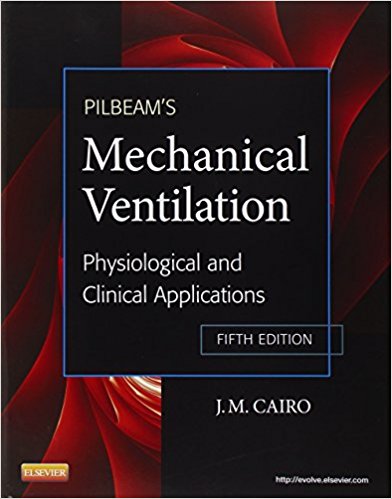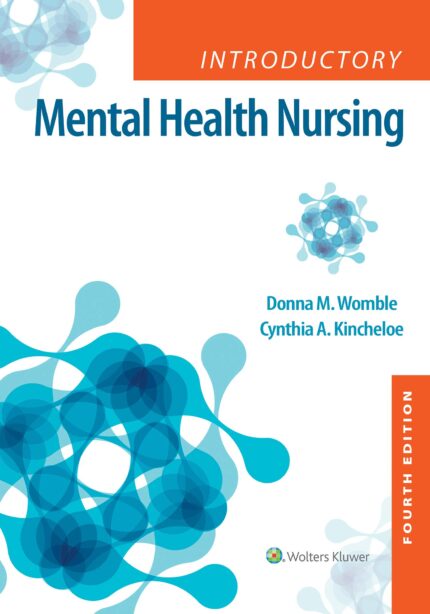Pilbeams Mechanical Ventilation 5th Edition By Cairo – Test Bank
Chapter 4; Establishing the Need for Mechanical Ventilation
Test Bank
MULTIPLE CHOICE
1.Respiratory failure due to inadequate ventilation is known as which of the following?
|
a. |
Hypoxemic |
|
b. |
Hypercapnic |
|
c. |
Compensated |
|
d. |
Chronic |
ANS: B
Inadequate ventilation decreases the amount of carbon dioxide excreted by the lungs. This causes a buildup of carbon dioxide in the blood, which is hypercapnia.
DIF: 1 REF: pgs. 49-51
2.The underlying physiological process leading to pure hypercapnic respiratory failure is which of the following?
|
a. |
Ventilation/perfusion mismatch |
|
b. |
Intrapulmonary shunting |
|
c. |
Diffusion impairment |
|
d. |
Alveolar hypoventilation |
ANS: D
When a person cannot achieve adequate ventilation to maintain a normal partial pressure of carbon dioxide in the arteries (PaCO2), it is known as acute hypercapnic respiratory failure. Ventilation/perfusion (V/Q) mismatch, intrapulmonary shunting, and diffusion impairment lead to hypoxemic respiratory failure.
DIF: 1 REF: pgs. 49-51
3.A patient with an opiate drug overdose is unconscious and has the following arterial blood gas results on room air: pH 7.20; partial pressure of carbon dioxide (PaCO2) 88 mm Hg; partial pressure of oxygen (PaO2) 42 mm Hg; bicarbonate (HCO3–) 25 mEq/L. Which of the following best describes this patient’s condition?
|
a. |
Chronic hypoxemic respiratory failure |
|
b. |
Chronic hypercapnic respiratory failure |
|
c. |
Acute hypoxemic respiratory failure |
|
d. |
Acute hypercapnic respiratory failure |
ANS: D
A drug overdose will affect the patient’s central nervous system, knocking out the patient’s respiratory center. This will cause an increase in the partial pressure of carbon dioxide in the arteries (PaCO2). The alveolar hypoventilation is causing the low partial pressure of oxygen (PaO2). If this was a chronic hypercapnic respiratory failure the patient’s bicarbonate level would be elevated above the normal level.
DIF: 2 REF: pg. 50
4.Acute hypercapnic respiratory failure may be caused by which of the following?
|
a. |
Decrease fractional inspired oxygen (FIO2) |
|
b. |
Pulmonary shunt |
|
c. |
Respiratory muscle fatigue |
|
d. |
Perfusion/diffusion impairment |
ANS: C
A decreased fractional inspired oxygen (FIO2), pulmonary shunt, and perfusion/diffusion impairment will lead to acute hypoxemic respiratory failure. Respiratory muscle fatigue would decrease a patient’s ability to “move air” and would cause acute hypercapnic respiratory failure.
DIF: 1 REF: pg. 50
5.Hypercapnic respiratory failure due to increased work of breathing will be caused by which of the following?
|
a. |
Drug overdose |
|
b. |
Myasthenia gravis |
|
c. |
Asthma exacerbation |
|
d. |
Pulmonary embolism |
ANS: C
An asthma exacerbation is characterized by bronchoconstriction due to bronchospasm, edema, and inflammation of the airways. This increases the amount of work a patient must do to overcome the increase in airway resistance, thereby increasing the patient’s work of breathing. A drug overdose causes hypercapnic respiratory failure, but because of a reduced drive to breathe. Myasthenia gravis is a neuromuscular disease that may paralyze the ventilatory muscles, causing a patient to not be able to move air. A pulmonary embolism would increase dead space by blocking off perfusion to a part of the lung. This would cause acute hypoxemic respiratory failure.
DIF:1REF:pg. 50; Box 4-2
6.A postoperative patient complaining of dyspnea is found to have tachypnea and tachycardia, and is somewhat confused. Breath sounds reveal end inspiratory crackles in both lung bases. An arterial blood gas is drawn and reveals the following: pH 7.49; partial pressure of carbon dioxide (PaCO2) 33 mm Hg; partial pressure of oxygen (PaO2) 51 mm Hg; arterial oxygen saturation (SaO2) 87%; bicarbonate (HCO3–) 25 mEq/L while on a 30% air entrainment mask. The most appropriate respiratory therapy intervention includes which of the following?
|
a. |
Initiate noninvasive positive pressure ventilation (NPPV). |
|
b. |
Initiate continuous positive airway pressure (CPAP) by mask. |
|
c. |
Administer bronchodilator therapy. |
|
d. |
Intubate and mechanically ventilate. |
ANS: B
This patient is showing signs and symptoms of hypoxemic respiratory failure due to post-operative atelectasis. This patient’s PaO2/FIO2 is below the critical value. Since the patient is still able to move air, intubation and mechanical ventilation, as well as noninvasive positive pressure ventilation (NPPV) are not appropriate at this time. This patient is not showing signs of increased work of breathing due to bronchospasm. Therefore, administering bronchodilator therapy is not appropriate. Initiating continuous positive airway pressure (CPAP) by mask will help to reverse the atelectasis and improve the patient’s oxygenation status.
DIF: 3 REF: pg. 50
7.A patient with inadequate oxygenation of the brain may display which of the following conditions?
1. Confusion
2. Excitement
3. Somnolence
4. Compliance
|
a. |
1 and 2 only |
|
b. |
1 and 3 only |
|
c. |
2 and 4 only |
|
d. |
3 and 4 only |
ANS: B
Confusion and somnolence are neurological findings with severe hypoxemia, which shows that the hypoxemia has affected the patient’s brain. The brain requires approximately 3.3 mL of oxygen per 100 grams of brain tissue per minute. Initially, the body responds to lowered blood oxygen by redirecting blood to the brain and increasing cerebral blood flow. Blood flow may increase up to twice the normal flow but no more. If the increased blood flow is sufficient to supply the brain’s oxygen needs, then no symptoms will result. However, if blood flow cannot be increased or if doubled blood flow does not correct the problem, symptoms of cerebral hypoxia will begin to appear. These symptoms include restlessness, disorientation, headaches, lassitude, somnolence, confusion, delirium, blurred vision, etc.
DIF:1REF:pg. 51; Table 4-1
8.A 28-year-old man is admitted to the emergency department with suspected drug overdose. The patient is obtunded and slightly cyanotic. The arterial blood gas results obtained while the patient was breathing room air were: pH 7.24; partial pressure of carbon dioxide (PaCO2) 58 mm Hg; partial pressure of oxygen (PaO2) 52 mm Hg; bicarbonate (HCO3–) 24 mEq/L. The most appropriate interpretation of these results is which of the following?
|
a. |
Chronic respiratory failure |
|
b. |
Hypoxemic respiratory failure |
|
c. |
Hypercapnic respiratory failure |
|
d. |
Acute orchronic respiratory failure |
ANS: C
This arterial blood gas shows an uncompensated respiratory acidosis with moderate hypoxemia. A patient with chronic respiratory failure would show an elevated bicarbonate (HCO3-) due to the chronic respiratory failure. A patient with acute or chronic respiratory failure would have an elevated partial pressure of carbon dioxide in the arteries (PaCO2) that is higher than what the patient’s current HCO3– can compensate for. Hypoxemic respiratory failure will only show a decreased partial pressure of oxygen in the arteries (PaO2) unless the hypoxemia is so severe that the patient’s ventilation is compromised.
DIF: 2 REF: pg. x
9.The respiratory assessment of a 44-year-old female patient diagnosed with myasthenia gravis shows: vital capacity 475 mL, maximum inspiratory pressure (MIP) -18 cm H2O. The patient is 5 feet 6 inches tall and weighs 188 lbs. The most recent arterial blood gas on a 2 L/min nasal cannula is pH 7.32, partial pressure of carbon dioxide (PaCO2) 49 mm Hg, partial pressure of oxygen (PaO2) 77 mm Hg, arterial oxygen saturation (SaO2) 95%, bicarbonate (HCO3–) 24 mEq/L.The most appropriate recommendation for this patient is which of the following?
|
a. |
50% air entrainment mask |
|
b. |
Continuous positive airway pressure |
|
c. |
Noninvasive positive pressure ventilation |
|
d. |
Intubation and mechanical ventilation |
ANS: D
The arterial blood gas result for this patient shows an acute respiratory acidosis. That along with a vital capacity of 7.4 mL/kg and the maximum inspiratory pressure (MIP) of -18 cm H2O point to the fact that this patient is also showing signs of muscle weakness that is progressively worsening. This requires prompt intubation and support to prevent acute respiratory failure. The 50% air entrainment mask and the continuous positive airway pressure (CPAP) will not provide support for this patient’s ventilatory problems. Noninvasive positive pressure ventilation (NPPV) is not appropriate for this patient because of the patient’s decreasing muscle strength.
DIF:3REF:pg. 53| pg. 58
10.Which of the following values are indicative of acute respiratory failure and the need for ventilatory support?
1. Maximum inspiratory pressure (MIP) = – 25 cm H2O
2. Dead space to tidal volume ration (VD/VT) = 0.4
3. Vital capacity (VC) = 8 mL/kg IBW
4. pH = 7.20
|
a. |
1 and 2 only |
|
b. |
2 and 3 only |
|
c. |
3 and 4 only |
|
d. |
1 and 4 only |
ANS: C
The critical values for the parameters listed are: maximum inspiratory pressure (MIP) -20 to 0, dead space to tidal volume (VD/VT) 0.3 to 0.4, vital capacity (VC) < 10 to 15 mL/kg ideal body weight (IBW), and pH < 7.25.
DIF: 2 REF: pgs. 52-54; Tables 4-2 and 4-3
11.A 46-year-old male presents to the emergency department with a chief complaint of shortness of breath. Physical assessment reveals: pulse 102, blood pressure 138/80, respiratory rate 25 with accessory muscle use, and breath sounds are decreased with bilateral inspiratory and expiratory wheezing with a prolonged expiratory phase. The peak expiratory flow rate is 100 L/min. The immediate action by the respiratory therapist should include which of the following?
|
a. |
Intubate and mechanically ventilate. |
|
b. |
Administer oxygen via nonrebreather mask. |
|
c. |
Administer continuous bronchodilator therapy. |
|
d. |
Initiate noninvasive positive pressure ventilation. |
ANS: C
It would be inappropriate at this time to intubate this patient because he is still moving air, as evidenced by his respiratory rate and breath sounds (although he may be tiring). Noninvasive ventilation is not appropriate for the same reasons. An arterial blood gas is necessary to establish the need for mechanical ventilation. This patient appears to be having an asthma exacerbation, as evidenced by his bilateral wheezing with a prolonged expiratory phase. The patient would probably benefit from oxygen therapy. However, the immediate problem and cause for alarm is his severe airflow obstruction, as evidenced by his breath sounds and peak expiratory flow rate (PEFR). Therefore, the most appropriate answer is to administer continuous bronchodilator therapy.
DIF:3REF:pg. 54| pg. 55














Reviews
There are no reviews yet.